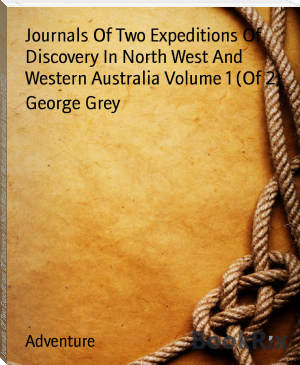Journals Of Two Expeditions Of Discovery In North West And Western Australia Volume 1 (Of 2), George Grey [robert munsch read aloud txt] 📗

- Author: George Grey
Book online «Journals Of Two Expeditions Of Discovery In North West And Western Australia Volume 1 (Of 2), George Grey [robert munsch read aloud txt] 📗». Author George Grey
Usual Level, As Was Evinced By The Weeds And Other Substances We Saw In
The Trees On Its Banks.
To Show That These Are Characteristics Of The Fitzroy River I Shall Quote
The Authority Of Captain Wickham From A Letter Addressed To Me Just
Before Our Meeting At Hanover Bay:
It (The Fitzroy) Appears To Be Very Similar To The Rivers On The
South-East Side Of New Holland, Subject To Dreadful Inundations, Caused
By Heavy Floods In The Interior, And In No Way Connected With The Rainy
Season On The Coast. Our Visit To It Being In February And March,
Immediately After The Rainy Season On The Coast, Without Our Seeing Any
Indication Of A Recent Flooding, Although There Were Large Trunks Of
Trees And Quantities Of Grass And Weeds Lying On The Bank And Suspended
From The Branches Of Trees From Ten To Twelve Feet Above The Level Of The
River. The Bed Is Entirely Of Sand.
...
Inundations.
It Will Be Clearly Seen How Nearly This Corresponds With What We Observed
About The Same Season On The Banks Of The Glenelg. I Have Therefore
Little Doubt That The Fitzroy Takes Its Origin From The Same Mountain
Chain, And That The Inundations Described By Captain Wickham Originate In
The Causes Which I Have Here Assigned.
To Demonstrate More Clearly The Similarity Of Character Of These Rivers
Volume 1 Chapter 12 (Physical Geography Commercial Prospects) Pg 169With Those Of New South Wales I Shall Quote Two Passages From The British
Colonies Of Mr. Montgomery Martin, Regarding The Hawkesbury And Hunter
Rivers Of That Colony:
The Hawkesbury, Which Is A Continuation Of The Nepean River, After The
Junction Of The Latter With A Considerable Stream, Called The Grose,
Issues From A Remarkable Cleft In The Blue Mountains In The Vicinity Of
The Beautiful Town Of Richmond, About Forty Miles From Sydney. Along The
Base Of These Mountains The Hawkesbury Flows In A Northerly Direction,
Fed By Numerous Tributary Mountain Torrents, Descending From Narrow
Gorges, Which, After Heavy Rains, Cause The Hawkesbury To Rise And
Overflow Its Banks As It Approaches The Sea. In One Instance It Rose Near
The Town Of Windsor Ninety-Seven Feet Above Its Ordinary Level. Volume 4
Page 257.
Again He Says, Page 258:
Hunter's River, About Seventy Miles To The Northward Of Port Jackson,
Disembogues Into The Sea At The Harbour Of Newcastle.
There Are Three Branches To The Hunter, Called The Upper, The Lower, And
The Middle: The Two Former Are Navigable For Boats For About 120 Miles,
And The Latter For About 200 Miles; But The Branches Are All Subject To
Sudden And Terrific Inundations Owing To The Rapid Descent Of Torrents
From The Blue Mountains.
...
Mouth Of The Glenelg.
In Concluding My Remarks On The Rivers Of The North-West I Should State
That Mr. Stokes, The Surveyor Of The Beagle, After A Careful Examination
Of The Coast Did Not Succeed In Finding The Mouth Of The Glenelg; And He
Imagines That It Has Several Openings, Consisting Of Large Mangrove
Creeks, Which Fall Into Stokes Bay; Whilst It Is My Impression That It
Will Be Found To Run Out Somewhere Between Camden Sound And Collier's
Bay, And That By Some Accidental Circumstance Its Mouth Was Missed. That
It Joins The Sea In A Considerable Body I Should Infer From A Shoal Of
Porpoises Having Been Seen High Up The River, And From The Rise And Fall
Of Tide, Which Was Twenty Feet At The Direct Distance Of Thirty Miles
From The Coast.
Valleys.
The Valleys In This Country Are Of Two Kinds: Those Which Are Almost
Ravines, Bordered On Each Side By Nearly Inaccessible Cliffs; And Valleys
Of Great Width, Bordered By Fertile Plains, Often Extensive, And Which
Occur Where The Basaltic Rocks Are Developed; Although Ravines Of This
Formation Are Also Of Frequent Occurrence In The Mountainous Parts.
Character Of The Valleys. Soil.
Volume 1 Chapter 12 (Physical Geography Commercial Prospects) Pg 170
The Soil Found In The Valleys Of The Former Kind Is Extremely Rich, But
They Are All Subject To Very Heavy Inundations. As An Example Of This
Kind Of Valley I May Cite The One In Which We First Encamped. Its Mean
Width Was Only 147 Feet, And The Rocky Precipitous Cliffs At Half A Mile
From The Sea Rose Above Their Base 138 Feet. These Deep Valleys
Undoubtedly Afford Water At All Seasons Of The Year.
The Sandstone Formation Is Intersected In All Directions By Valleys Of
This Kind, Which Are Seldom More Than From Two To Three Miles Apart,
While The Top Of The Range Between Them Is A Tableland, Divided By
Lateral Valleys And Gently Rising Towards The Interior. Seawards They All
Terminate In Saltwater Creeks, Having The Same Narrow, Rocky, And
Precipitous Character As They Present Themselves.
These Tablelands Afford Good Timber, Particularly Pine. Sheep Thrive Upon
The Food There Produced, But We Found Goats Did Not Answer So Well.
The Richest Land In This Part Of The Country Is Found In The Valleys Of
The Second Class. The Streams Flowing Through These Valleys Have
Generally Almost Imperceptible Currents And Often Form Wide Reaches. The
Land Upon Their Margins Is Thinly Wooded; And I Have Often Seen Exposed
Fine Vegetable Mould Of Ten Or Twelve Feet In Thickness, Through Which
These Streams Had Worn Their Way. Good Examples Of This Kind Of Valley
Are Those Through Which Run The Fitzroy And Glenelg Rivers.
The Northern Banks Of Prince Regent's River I Conceive To Offer No
Inducement Whatever For The Formation Of A Settlement, The Whole Of The
Country In That Direction, As Far As I Have Seen, Consisting Entirely Of
Sandstone Ridges. These Ridges Are Continually Intersected By Valleys, Or
Rather Ravines Of Great Fertility, But They Are So Narrow, And The Good
Land Contained In Them Is So Very Limited In Extent, That From The First
Moment Of The Establishment Of A Colony Here The Individuals Composing It
Must Necessarily Be Scattered Over A Large Space Of Country. They Would
Thus Be Separated From One Another By Considerable Intervals, Which
Separation Would Not Only Render Them More Liable To Disagreements With
The Natives, But Would For Many Other Reasons Be Highly Detrimental To
The Interests Of An Infant Colony.
The Same Objection Holds Good With Regard To The South Bank Of This
River, As Far As The Longitude Of 125 Degrees 3 Minutes East, And Even
After Passing This Point The Land Immediately Bordering The River Is Of
The Same Sterile Character; However A Creek Which Trends Nearly South
Runs Up From Thence Into One Of The Most Fertile Countries I Have Ever
Seen.
Harbours.
The Coastline To The South Of Prince Regent's River Is Indented, As Shown
Upon Captain King's Chart, By Numerous Deep Bays, Many Of Which Afford
Volume 1 Chapter 12 (Physical Geography Commercial Prospects) Pg 171Excellent Anchorage; Indeed I Believe That There Is No Other Part Of The
World In Which An Example Occurs Of Three Such Fine Harbours As Port
George The Fourth, Hanover Bay, And Camden Sound, Lying So Close To One
Another.
These Harbours Alone Render This A Point Of Considerable Consequence To
Great Britain; But When Viewed In Connexion With The Fine Tract Of
Country Lying Behind Them Its Importance Is Very Materially Increased.
Commercial Advantages.
Should This Part Of Australia Be Found Eligible For Colonization Its
Commercial Importance Is Well Worthy Of Consideration.
Productions Suited For Cultivation. Cotton Trade.
The Cultivated Productions For The Growth Of Which The Country And
Climate Seem Best Adapted Are Cotton, Sugar, Indigo, And Rice.
A Species Of Cotton Plant Grows Wild In The Greatest Abundance, And If A
Colony Was Established And The Proper Cotton-Plant Introduced The
Following Advantages Would Be Obtained:
Great Britain Would Possess In Northern Australia A Colony Standing In
The Same Relation To Her Manufacturies For Cotton That Her Colonies In
The South Do To Her Wool-Market.
This Colony Would Also Form A Sort Of Entrepot To Which The Manufactured
Cotton Would Again Be Exported For The Purpose Of Sale In The Islands Of
The Indian Archipelago Or Its Vicinity, And Other Parts Where We Have At
Present No Trade, And Where Printed Cottons Now Are, And From The Nature
Of These Countries Must Constantly Be, In Great Demand.
Thus A Fresh Supply Of Cotton For Our Markets Would Be Obtained, Which,
Coming From An English Colony, Would Give Employment To British Vessels
Alone, And The Industry Of Our Manufacturers Would Be Called Into
Operation By An Entirely New Market For Cotton Goods Being Thrown Open To
Them, In Which The Demand For These Articles Is Far Greater Than The
Supply Could Be For Many Years.
Articles Of Export.
The Natural Productions That Are At Present Found In North-West Australia
And Might Be Available For Exportation Consist Chiefly Of Timber, Gum,
Lichens, And Mimosa Bark; All Of Which Are Abundant, And Might Be
Collected With A Trifling Degree Of Labour.
There Are Many Varieties Of Useful Timber. Among Others, Pine, Fit For
The Purposes Either Of Building Or Making Spars For Vessels, Is Abundant
And Good, And Could Be Readily And Cheaply Exported If They Were Cut In
The Vicinity Of The Streams And Floated Down To The Sea In The Rainy
Season, Whereby All Land Carriage Would Be Avoided.
Volume 1 Chapter 12 (Physical Geography Commercial Prospects) Pg 172
I Sent To England Specimens Of Five Different Gums In Order That They
Might Be Examined. These Consist Of An Elastic Gum, Closely Resembling
Indian Rubber, Gum Tragacynth, Another Gum Yielded By A Sort Of Capparis
And Which I Believe To Be Hitherto Unknown, And Two Kinds Of Gum Resin.
The Mosses Are Of Various Kinds, Many Of Which Would Afford Useful Dyes;
And These, Together With The Gums, Would Probably Be Found Valuable
Articles Of Export; For The Collecting Of





Comments (0)